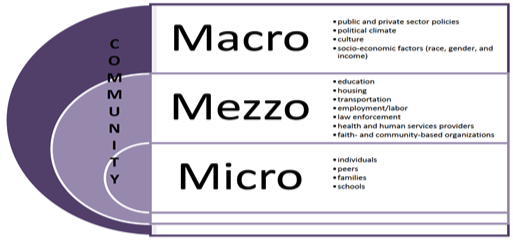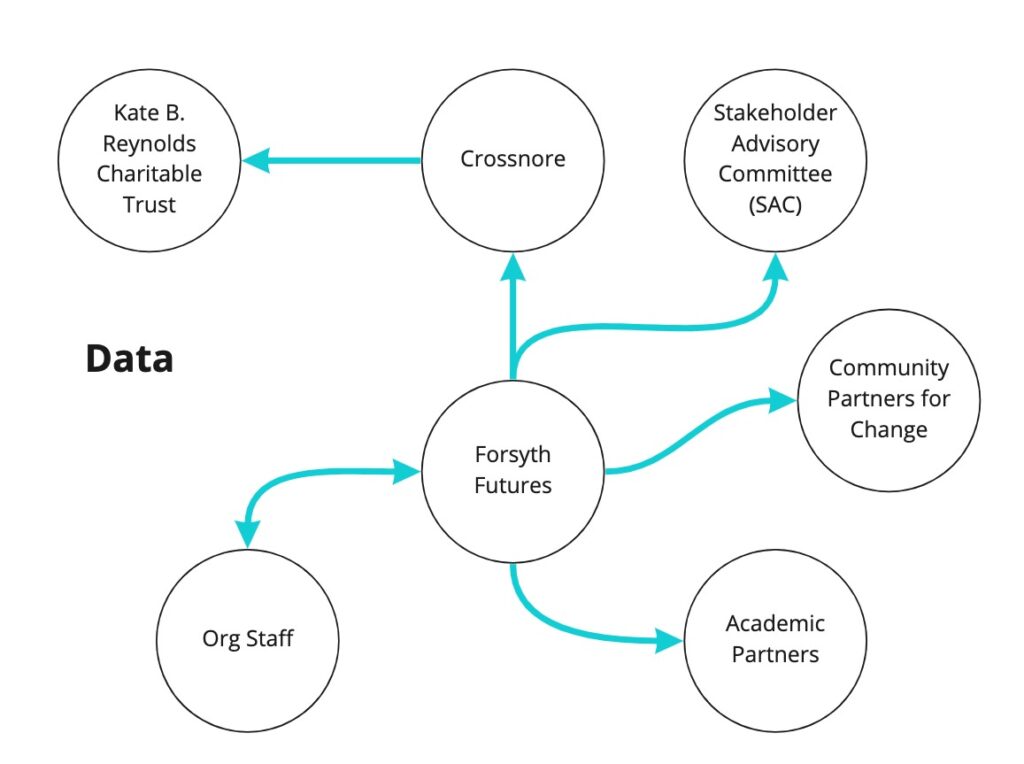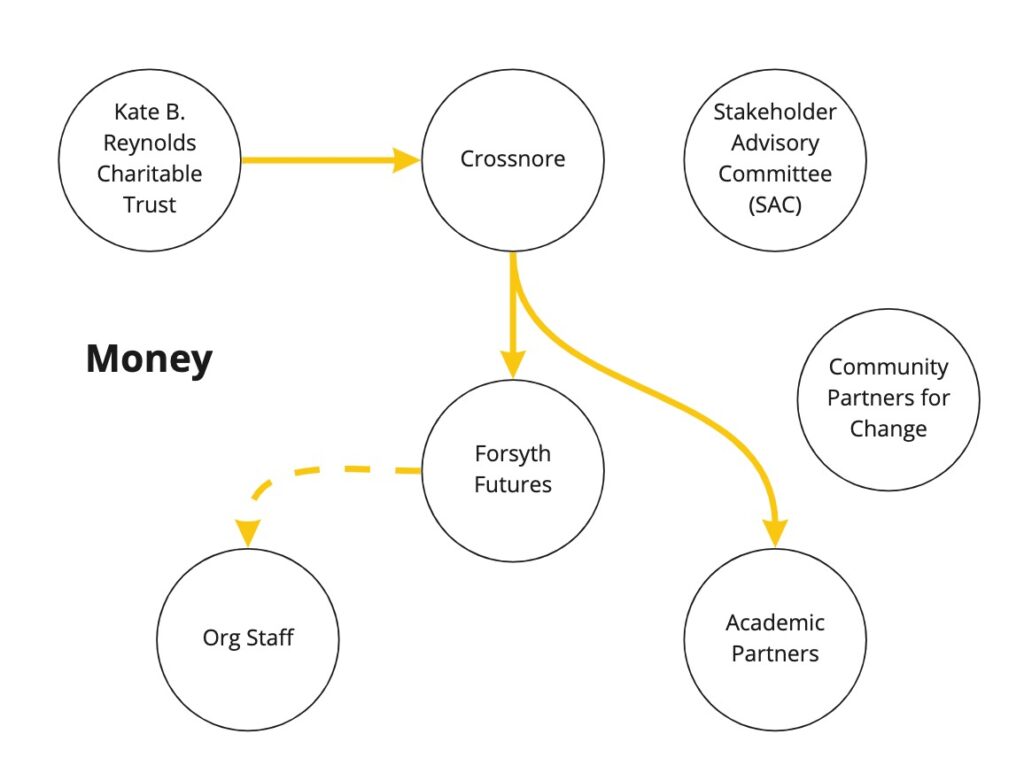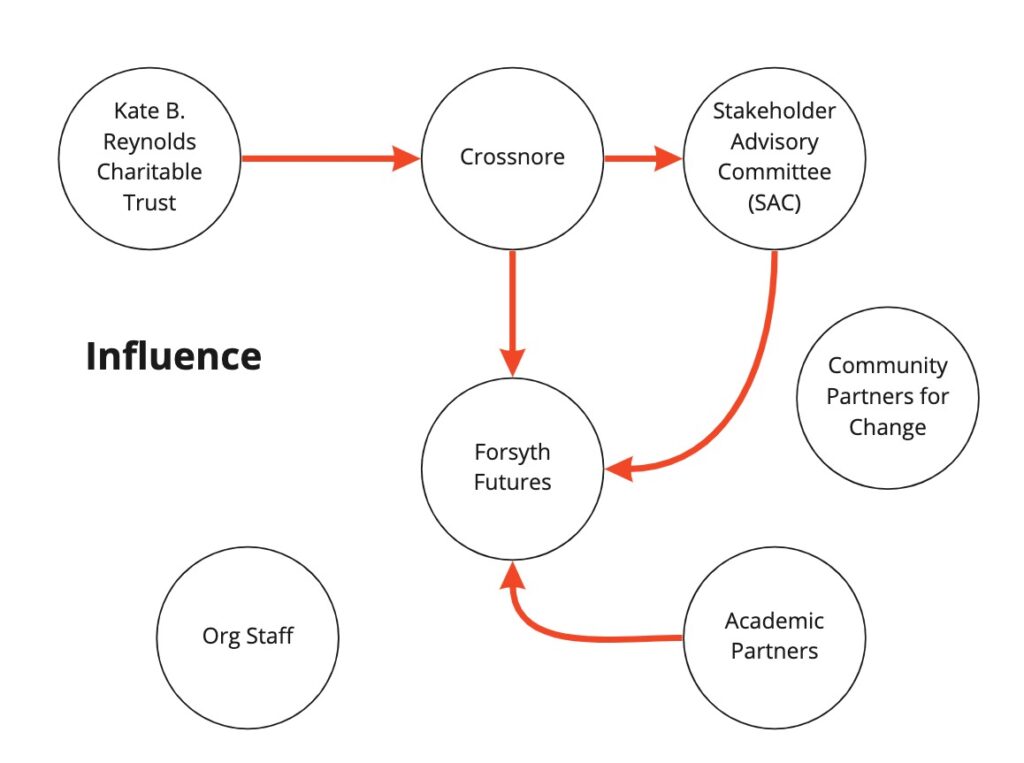
Forsyth County, North Carolina
Project Background
To reduce the occurrences and impact of Adverse Childhood Experiences (ACEs) and toxic stress among young children, the Kate B. Reynolds Charitable Trust put out a call for proposals to support research, planning, and education related to building trauma-informed early childhood systems in Forsyth County.
The Center for Trauma Resilient Communities (CTRC) responded to this call for proposals with a plan to lead research teams from Wake Forest Baptist Health and Forsyth Futures to collect information to inform CTRC’s development of a strategic plan. For our part, Forsyth Futures produced a report that includes information gathered at the mezzo (organizational) level. It answers questions about the broader community context; child-serving staff’s own experiences of ACEs, COVID-19, and secondary traumatic stress; child-serving organizations’ current familiarity and alignment with the TRC model; and the ability of organizations’ staff to bring about systems change through transformational leadership.
View the full technical report: Trauma Resilient Community Mezzo-Level Assessment: Systems and Institutions.
The full mezzo-level report is extensive and highly technical. To make the content and critical findings of the report more useful to community stakeholders, Forsyth Futures staff are producing a series of blog posts that explore the following topics:
- What is trauma and why does it matter? (see below)
- Stress and Trauma Experienced by Staff at Child Serving Organizations (forthcoming)
- Where are child-serving organizations in our community on their journey to being trauma informed? (forthcoming)
- What was learned from the assessment, and what are next steps? (forthcoming)
Additionally, Forsyth Futures will host a ‘lunch and learn’ webinar about the mezzo-level report from 12:00 – 1:00 PM on Tuesday, April 5, 2022 (click to register). A recording of that webinar, along with supporting materials will be posted to this page after the fact.
What is trauma and why does it matter?
Trauma happens when the internal and external resources of individuals or communities are not enough to cope with an external threat, and it is a kind of adversity that has a lasting impact on those individuals or communities (Middleton, J. et al, 2020, September 15). Because people’s experiences build and impact the brain’s architecture, trauma responses trigger survival mode reactions such as fight, flight, freezing, or collapsing. There are different types of trauma, including racial and historical trauma, that can impact people and communities in different ways. Some examples of traumatic events can include childhood abuse, domestic violence, sexual abuse, and neglect. Trauma can have long-term impacts on physical and mental health (Middleton, J. et al, 2020, September 23).
For example, a Centers for Disease Control and Prevention (CDC) and Kaiser Permanente study found that Adverse Childhood Experiences (ACEs), traumas experienced in childhood, could have long-term impacts on the health of people who experienced them. Though this is not an exhaustive list of traumas, this study included the following experiences in its definition of ACEs:
- physical, emotional, and sexual abuse;
- physical and emotional neglect; and
- household-level experiences such as
- domestic violence in the household,
- parental divorce, and
- a member of the household experiencing
- mental illness,
- incarceration, or
- substance abuse.
This study found that in a middle-class, working group of adults, those who had experienced four or more ACEs had significantly worse health outcomes (Middleton, J. et al, 2020, September 23). For example, they were twice as likely to smoke cigarettes, seven times more likely to be alcoholics, twice as likely to have cancer and heart disease, ten times more likely to have injected street drugs, and twelve times as likely to have attempted suicide. The study generally found that people who had experienced more ACEs were at higher risk for negative health outcomes. Importantly, factors that increase childrens’ resilience to ACEs can mitigate outcomes and help reduce childrens’ risk of negative long-term outcomes.
What is the Trauma Resilient Community Model?
The primary goal of the Trauma Resilient Community (TRC) Model is to support organizations in creating congruent trauma-informed knowledge, language, practices, values, and culture. Having shared knowledge as the foundational building block provides an organization with the tools to create and sustain organizational change. The TRC Model interweaves resilience building, equity and justice, Adverse Childhood Experiences, organizational chronic stress, trauma science, and compassion fatigue throughout and is informed by seven trauma-informed norms and values:
- nonviolence,
- emotional intelligence,
- social learning,
- open communication,
- social responsibility,
- democracy, and
- growth and change.
The TRC framework defines community at three levels – the micro, mezzo, and macro levels:
- The micro level focuses on individuals, peers, families, and schools.
- The mezzo level focuses on the systems and institutions which impact communities, such as education, housing, transportation, employment / labor, law enforcement, health and human service providers, faith-based institutions, and community-based organizations.
- Macro level factors include public (government) and private (corporations) sector policies; political climate; culture; and socio-economic factors such as race, gender, and income.

The Center for Trauma Resilient Communities (CTRC) is focusing much of its initial work on the mezzo-level. Organizations at the mezzo-level are particularly vulnerable to chronic stress from a combination of internal and external factors, including their work with traumatized clients, the trauma and stress of individual staff members, organizational factors, and broader social and economic factors impacting the whole community (Middleton, J. et al, 2020, September 30). This chronic stress can create toxic environments that are harmful to both staff and clients.
To learn more, visit the Center for Trauma Resilient Communities’ website.
Methodology
What information was collected and how?
The Stakeholder Advisory Committee (SAC), a committee made of organizational representatives and researchers, chose the mezzo-level research topics that analysts studied and which groups this information should be collected from.
The focus of study for the mezzo-level research was on agencies and organizations that serve children and their staff. The SAC asked analysts to include the following kinds of organizations (called child-serving organizations in the report) when they collected data:
- Winston-Salem / Forsyth County Schools,
- child care providers,
- home visitation programs,
- social service providers (for example Department of Social Services and the Department of Public Health), and
- medical service providers.
The topics that the SAC asked analysts to study were:
- general information about what Forsyth County is like, especially in relation to things that could impact experiences of trauma;
- the number and kinds of ACEs staff at child-serving agencies have experienced themselves;
- how many staff members at child-serving agencies reported having been discriminated against;
- how (and the extent to which) staff at child-serving agencies had been impacted by COVID-19;
- how much staff at child-serving agencies experience stress or trauma from their work with clients who have experienced trauma;
- how much staff at child-serving agencies know about the TRC model;
- how well the work environment, staff practices, and leadership practices at child-serving agencies line up with the TRC model; and
- how staff at child-serving agencies have experienced or observed structural violence and racial justice practices where they work.
To gather general information about Forsyth County, the SAC asked analysts to read and summarize reports that had already been written by other agencies describing the community that were asset-based and / or conducted by researchers who identified as Black, Indigenous, and People of Color (BIPOC) or by organizations lead by people who identified as BIPOC in the community. More details on how this was done can be found in the technical report.
Analysts worked with the SAC and researchers from the Center for Trauma Resilient Communities (CTRC) to design a survey for organizations to take; this survey gathered information about staff experiences of ACEs, discrimination, COVID-19, and stress from working with clients; knowledge about the TRC model; and how well organizations’ environment, staff practices, and leadership practices lined up with the TRC model. It included several series of questions, called scales, that have been tested in other communities to measure things that may otherwise be difficult to measure with just one or two questions, like what style of leadership exists in an organization or what the social environment of an agency is like.
The following scales were used in this survey:
- The Pediatric ACEs and Related Life Events Screener (PEARLS) for adults was used to measure experiences of ACEs;
- the Secondary Traumatic Stress Scale Survey was used to measure symptoms of stress that staff may experience from working with clients with trauma;
- the Environmental Assessment Survey was used to measure the physical and social environments of the organization and the seven commitments of the TRC model;
- the Trauma-Informed Staff Practice Survey was used to measure how well staff practices lined up with the TRC model; and
- the Global Transformational Leadership Scale was used to measure transformational leadership, a style of leadership that is aligned with the TRC model and important for making organizational changes.
Analysts reached out to leaders of the organizations identified by the SAC and asked them to invite their staff to participate in the survey online. More information on how the survey was designed and analyzed and who answered the survey and the organizations they worked for can be found in the technical report.
Analysts were not able to find any scales for measuring structural violence or racial justice practices for staff working at organizations. To gather this information analysts conducted phone and video call in-depth interviews with staff at the organizations identified by the SAC as well as staff at some of the nonprofits and organizations that help coordinate early childhood work in Forsyth County. (The SAC recommended those additional organizations for the interviews.) To conduct the interviews, analysts asked organizational leaders to invite or recommend staff members to participate in the interviews. More information on how the interviews were conducted and who participated can be found in the technical report.
How did analysts determine what we know from this information?
Information Gathered from the Surveys
To analyze the information gathered in the surveys, analysts used instructions provided by the researchers who wrote the scales to calculate the scores. They also ran tests to make sure that people answered questions consistently, a sign that the scales were working as expected and made a note in the report if something about how people answered the questions in the scale seemed unusual. (The statistical results of these tests are also included in Appendix C of the technical report.) If someone answering a survey skipped a question in a particular scale, their answers on that scale were not used, but the information they provided on other scales was used.
When comparing how scores were different for different groups of people answering the survey, analysts ran tests to make sure that they were at least 95% sure that the differences in scores they saw were real differences between those groups that were not the result of random chance. Information from specific groups was only included in graphs in the technical report if analysts were at least 95% sure that differences existed between one or more groups. For example, some graphs may include information about responses by income while others do not; this information was only included if these kinds of differences were found between at least two income groups. If there is more than one group, the groups that were different from each other are described in the text under the graph. In the same way, analysts only described differences in key findings, presentations, and other materials if they were at least 95% sure that the differences were large enough to not be the result of random chance. (Specific statistical tests and their outputs are available in Appendix A of the technical report.) More information about how the survey data was analyzed can be found in the technical report.
Information Gathered from Interviews
Analysts asked the staff members they interviewed one open-ended question about structural violence, and the rest of the interview questions were based on a survey instrument, the “Racial Justice Assessment Tool” developed by the Western States Center, that helps organizations understand how much their organization is doing to address racial equity across different areas, like workplace culture and policies. Recordings from these interviews were transcribed, and analysts reviewed the transcriptions to identify major themes. All of the major themes reported were agreed on by two analysts. More detailed information on how interviews were analyzed is available in the technical report.
What can't we know from this information?
- These surveys and interviews were conducted in the late spring and early summer of 2021. Organizations and their staff may have changed environments and practices since then, especially since CTRC has continued to work in the community.
- The people who ended up taking surveys and participating in interviews for this project were not selected randomly. The survey instrument was very long and dealt with sensitive issues; some of the questions may not have been easy for respondents to understand or relevant to their workplaces, which may have made some people more likely to skip questions or not finish the survey than others. We can’t know if experiences and perspectives of staff members who participated are the same as those who did not participate.
- Analysts were only able to study how people answered questions differently by looking at one part of the respondents’ identities at a time (for example, looking at how questions were answered by field of work or level of education). However, analysts were not able to measure or control for cases where these identities may overlap. (In the case of the earlier example, people with doctoral degrees may also be more likely to work in pediatric offices. And, in cases where analysts saw that people with doctoral degrees and people employed in pediatric offices answered questions in similar ways, analysts were not able to tell if people answering the surveys with doctoral degrees were actually more likely to give a particular kind of answer because of their education or if it was really because they were more likely to work in pediatric offices and the real difference is because of something about working in a pediatric office.)
- When organizations and staff were invited to participate in surveys and interviews, they were told that the answers given by their organizations would not be identified in public reports. Analysts did notice that there were consistent differences in how staff from different organizations answered questions, and participants across the whole survey gave a wide range of answers to questions. Scores for individual organizations are likely different from the total scores for all of the participants. As long as an organization had enough staff members participate so that analysts can report on their survey results without violating the privacy of anyone who answered the survey, individual organizations will receive follow-up reports with information just for their organizations. But, those reports will not be made public by Forsyth Futures.
- For the interviews about racial equity practices, some participants were not familiar with the TRC model or with some of the terms used, and the researchers provided clarifications. This may have impacted their responses.
References
- Middleton, J. et al. (2020, September 15). Building Trauma Resilient Systems Winston-Salem/Forsyth (“BTR” Winston-Salem”) [Google Slides]. Center for Trauma Resilient Communities.
- Middleton, J. et al. (2020, September 23). Building Trauma Resilient Systems Winston-Salem/Forsyth [Google Slides]. Center for Trauma Resilient Communities.
- Middleton, J. et al. (2020, September 30). Building Trauma Resilient Systems Winston-Salem/Forsyth (“BTR Winston-Salem”) [Google Slides]. Center for Trauma Resilient Communities.
For questions about the source content referenced above, please contact Marni Eisner at meisner@crossnore.org.
Do you have a question about this article?
Did you find this information useful?
We would love to hear from you.
@ForsythFutures



